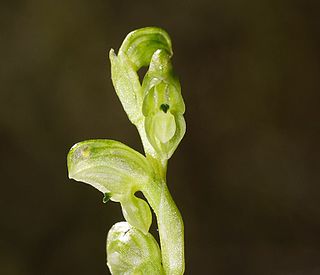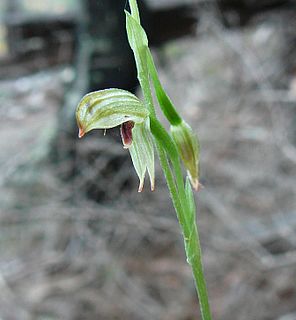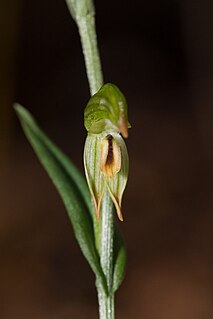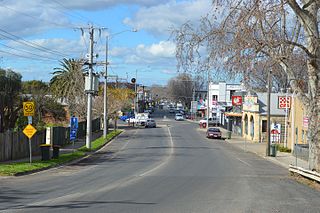
Pterostylis coccina, commonly known as the scarlet greenhood, is a species of orchid endemic to eastern Australia. As with similar greenhoods, the flowering plants differ from those which are not flowering. The non-flowering plants have a rosette of leaves flat on the ground but the flowering plants have a single flower with leaves on the flowering spike. In this species, the rosette leaves are relatively large and dark green, and the flowers are white, and bluish-green or red. It grows in New South Wales and north-eastern Victoria.

Pterostylis cycnocephala, commonly known as the swan greenhood, is a plant in the orchid family Orchidaceae and is endemic to south-eastern Australia. It has a rosette of leaves and up to 24 green flowers which have a labellum with a dark green, beak-like appendage. It is widespread and common from the Darling Downs in Queensland to Tasmania, usually growing with grasses.

Pterostylis crassicaulis, commonly known as the alpine swan greenhood, is a plant in the orchid family Orchidaceae and is endemic to south-eastern Australia. It has a rosette of leaves and up to 18 bluish-green and white flowers with dark green stripes. The flowers have a labellum with a dark green, beak-like appendage. It is similar to P. cycnocephala but is more robust and grows at higher altitudes.

Pterostylis macilenta is a plant in the orchid family Orchidaceae and is endemic to the Grampians National Park in Victoria. As with similar greenhoods, the flowering plants differ from those which are not flowering. The non-flowering plants have a rosette of leaves flat on the ground but the flowering plants have up to six translucent, dark green flowers and lack a rosette.

Pterostylis pedoglossa, commonly known as the prawn greenhood, is a species of orchid endemic to south-eastern Australia. There is a rosette of leaves at the base and flowering plants have a single white flower with green stripes, sometimes with a brownish tinge on the tip, and a long, thread-like labellum.

Pterostylis bicolor, commonly known as the black-tip greenhood, is a plant in the orchid family Orchidaceae and is endemic to south-eastern Australia. It has a rosette of leaves and when flowering, three to ten well-spaced, bright green flowers with a blunt, greenish-black appendage on the labellum. It is similar to the swan orchid, Pterostylis cycnocephala but that species has a beak-like appendage and crowded flowers.

Pterostylis tunstallii, commonly known as Tunstall's greenhood or granite greenhood is a plant in the orchid family Orchidaceae and is endemic to south-eastern Australia. Flowering plants have up to ten transparent green flowers which have a dark brown, insect-like labellum with a blackish "head". Non-flowering plants have a rosette of leaves on a short stalk but flowering plants lack the rosette, instead having five to eight stem leaves.

Pterostylis vittata, commonly known as the banded greenhood or green-banded greenhood, is a plant in the orchid family Orchidaceae and is endemic to the south-west of Western Australia. The plants either have a rosette of leaves on a short stalk in the years when not flowering or stem leaves on a flowering spike. When flowering, it has up to about twenty five flowers which are translucent green with darker green stripes. It was formerly thought to occur in South Australia and Victoria but those collections are now thought to be of Pterostylis sanguinea.

Pterostylis jonesii, commonly known as the montane leafy greenhood, is a plant in the orchid family Orchidaceae and is endemic to a small area of south-eastern Australia. Individual plants have either a rosette of three to six leaves or a flowering spike with up to eleven flowers and five to seven stem leaves. The flowers are translucent green with faint darker green lines and have a brownish-yellow labellum with a dark stripe.

Pterostylis multiflora, commonly known as the tall tiny greenhood, is a species of orchid endemic to south-eastern Australia. As with similar orchids, plants in flower differ from those that are not. Those not in flower have a rosette of leaves lying flat on the ground. Plants in flower lack a rosette but have up to twenty tiny green, white, and brown flowers in summer. The flowering stem has up to six stem leaves.
Pterostylis clivicola is a plant in the orchid family Orchidaceae and is endemic to a small area near the border between New South Wales and Victoria. It has a rosette of leaves and up to fourteen green flowers which have a labellum with a dark green, beak-like appendage.
Pterostylis conferta, commonly known as the leprechaun greenhood or basalt midget greenhood, is a plant in the orchid family Orchidaceae and is endemic to Victoria. It has a rosette of leaves at the base of the flowering stem and up to sixteen pale green flowers in a short, crowded spike. It is a very rare orchid, similar to P. mutica, its distribution much reduced by urbanisation and agriculture.
Pterostylis incognita, commonly known as the Sale greenhood, is a plant in the orchid family Orchidaceae and is endemic to Victoria. It has a rosette of leaves and when flowering, up to twelve crowded flowers on a stem with a rosette at the base. The type specimen was collected near Sale in 1895 but was not formally described or given a name until 2009, by which time it was presumed extinct.

Pterostylis prasina, commonly known as the mallee leafy greenhood, is a plant in the orchid family Orchidaceae and is endemic to southern continental Australia. Non-flowering have a rosette of leaves on a short stalk, but flowering plants lack the rosette and have up to eight pale green and translucent green flowers with darker green lines. The flowers have a pale green labellum with a darker central line. It is a common and widespread greenhood in parts of Victoria and South Australia.
Pterostylis pratensis, commonly known as the Liawenee greenhood, is a plant in the orchid family Orchidaceae and is endemic to Tasmania. Both flowering and non-flowering plants have a rosette of leaves lying flat on the ground. Flowering plants have up to twelve crowded white flowers with prominent green stripes. This greenhood only grows in low, exposed subalpine tussock grassland.
Pterostylis spissa, commonly known as the cygnet greenhood, is a plant in the orchid family Orchidaceae and is endemic to Victoria. Both flowering and non-flowering plants have a rosette of leaves lying flat on the ground and flowering plants have up to twelve small, green flowers which have a green labellum with a dark green beak-like appendage.
Pterostylis stenosepala, commonly known as the narrow-sepalled leafy greenhood, is a plant in the orchid family Orchidaceae and is endemic to New South Wales. Flowering plants have up to six shiny, translucent green flowers with darker green stripes. The flowers have an insect-like labellum which is green with a dark green mound on its upper end. Non-flowering plants have a rosette of leaves on a stalk, but flowering plants lack the rosette, instead having between four and eight stem leaves.
Pterostylis tanypoda, commonly known as the swan greenhood, is a species of greenhood orchid endemic to New Zealand. Both flowering and non-flowering plants have a rosette of leaves lying flat on the ground and flowering plants have up to seven crowded, inconspicuous bluish-green and white-striped flowers.
Pterostylis wapstrarum, commonly known as the fleshy greenhood, is a plant in the orchid family Orchidaceae and is endemic to Tasmania. Both flowering and non-flowering plants have a rosette of leaves lying flat on the ground and flowering plants have up to fifteen crowded green flowers with darker green veins.
Pterostylis ziegeleri, commonly known as the Cape Portland greenhood, is a plant in the orchid family Orchidaceae and is endemic to Tasmania. Both flowering and non-flowering plants have a rosette of leaves lying flat on the ground and flowering plants have up to eight crowded translucent, pale green flowers with darker green veins.




















